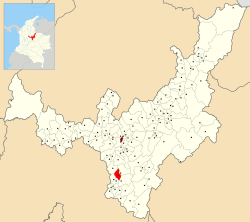Pachavita facts for kids
Quick facts for kids
Pachavita
|
||
|---|---|---|
|
Municipality and town
|
||

View of mountain within Pachavita
|
||
|
||

Location of the municipality and town of Pachavita in Boyacá
|
||
| Country | ||
| Department | Boyacá Department | |
| Province | Neira Province | |
| Founded | 17 November 1716 | |
| Area | ||
| • Municipality and town | 68 km2 (26 sq mi) | |
| Elevation | 1,985 m (6,512 ft) | |
| Population
(2015)
|
||
| • Municipality and town | 2,508 | |
| • Urban | 395 | |
| Time zone | UTC-5 (Colombia Standard Time) | |
| Website | Official website: http://www.pachavita-boyaca.gov.co/ | |
Pachavita is a small town and a type of local government area called a municipality in Colombia. It's located in the Boyacá Department, which is like a state or province. Pachavita is part of the Neira Province within Boyacá.
This town sits high up on a plateau called the Altiplano Cundiboyacense, about 1,985 meters (6,512 feet) above sea level. It is about 85 kilometers (53 miles) away from Tunja, the capital city of the Boyacá Department. Pachavita shares its borders with other towns: Chinavita to the north, Tenza and La Capilla to the south, Garagoa to the east, and Úmbita to the west.
Contents
What Does the Name Pachavita Mean?
The name Pachavita comes from the Chibcha language, which was spoken by the native people of this area. The word pacha means "man" or "lord," and vita means "point," "summit," or "peak." So, Pachavita can mean "Peak of the man." Another possible meaning is "Proud chief."
A Look Back in Time: Pachavita's History
Before the Spanish conquistadores arrived in Colombia, the area where Pachavita is now was part of a large group of native communities called the Muisca Confederation. The Muisca people had different leaders, and the zaque (a powerful ruler) of Hunza was in charge of the Pachavita area.
The modern town of Pachavita was officially founded on November 17, 1716.
How Pachavita Makes a Living: Economy
The main ways people in Pachavita earn money are through agriculture (farming) and dairy farming. Farmers grow many different crops, including yuca, maize (corn), bananas, arracacha, beans, lulo, and cucumbers. They also produce eggs, peas, and cheese.
See also
 In Spanish: Pachavita para niños
In Spanish: Pachavita para niños


